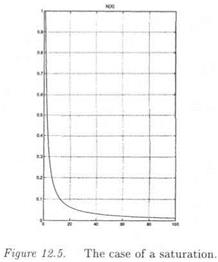AN EXTENSION
In the above method, /ад2(Fu(P(juj), N(X, u))) is to be computed at each point (X, u>) of a gridding. The robustness margin r(X, u>) is then visualized as a function ofX and ы on a 3D plot (see section 5.). Nevertheless, a peak value of y&2(Fu(P(juj),N(X, uj))) may be missed with such a gridding (i. e. when this peak value lies between two points of the gridding), and the robustness properties of the closed loop would be overevaluated.
A simple method is proposed here for avoiding a gridding of the magnitude X, by treating this magnitude (more precisely the SIDF N(X, u>)) as an additional (fictitious) uncertainty. Frequency ш is fixed. An augmented skewed Ц problem is obtained. Even if the method is not applicable to all kinds of nonlinearities, it can be applied to a large class of usual (especially memoryless) ones.
• The aim of this subsection is to compute the robustness margin r(o>)
r(ui) = min_ r(X, w) (12.24)
хє[£, X]
Lemma 3..5 provides an alternative definition of r(u>). The proof is trivial when using Proposition 3..3.
LEMMA 3..5 If:
l/r{u) < l/HA2(P22(ju)) _
2/ det(I – Pn(ju})N(X, u})) ф 0 for all X Є [X, X]
then:
 -ГТ = max_ /j, A2{Fu{P(ju>),N{X, u>))) r(u) xe[x, x]
-ГТ = max_ /j, A2{Fu{P(ju>),N{X, u>))) r(u) xe[x, x]
• Consider first a classical nonlinearity, namely a saturation у = Ф(ж)
у = x if x < 1 = +1 if X > 1
= -1 if X < -1 (12.26)
The associated SIDF N(X), which does not depend on frequency u> and which is a real scalar, can be computed as (see also Figure 12.5):
With respect to Figure 12.5 and equation (12.27), it is obvious that X € [0, oo] leads to N{X) Є [0, 1].
|
|
• Consider now the generic case of a memoryless SISO nonlinearity: here again, the SIDF N(X) is a real scalar which does not depend on frequency и). X Є [X, X] can thus be translated into N(X) Є [jV, N], The idea is thus to rewrite N(X) as:
N{X) = a0 + a xx (12.28)
where the oti s are chosen so that x — [ — 1 , 1 ] leads to N(X) є [N, IV].
• In the general case of a diagonal MIMO memoryless nonlinearity Ф = сІіад(Фі), the SIDF can be written as:
N(X) = Z0 + ZiA і (12.29)
where the Zi s are fixed diagonal matrices and Ді = diag(xi). X denotes now a vector of magnitudes Xu while_N(X) is a diagonal matrix. Here again, Ді Є D leads to N(X) e [N_, N], • Applying now equation (12.29) to Figure 12.3, this Figure can be transformed into Figure 12.4, where:
■ the fictitious real model perturbation — i contains the uncertainties Xi in the magnitude vector X, or equivalently in the SIDF N(X).
■ the real model perturbation Д2 contains the true parametric uncertainties.
■ Matrices Zi ’ s are incorporated in the transfer matrix P(s).
The following Proposition presents a method for computing r(u). PROPOSITION З..6 Let the interconnection structure of Figure 12.4. If:
1/г{ш) < 1/мд2(РЫ. Н)
2//W-PiiO’w)) < 1
then:
|
|
г’д(P(jw)) is the skewed s. s.v. associated to the complex matrix P(jaj) and to the real model perturbation Д = diag{Aі, Дг)- Ді is to be maintained inside its unit hypercube D.
Remarks:
(i) The assumptions of this Proposition are essentially extensions of the assumptions in Proposition 3..3. Note especially that the second assumption in Proposition 3..6 means that the necessary condition of oscillation is not satisfied by the nominal closed loop system, for frequency to and for a vector of magnitudes X є [X, X].
(ii) A frequency gridding can be avoided, by treating ю as an additional uncertainty in an augmented ц problem (see section 3. of chapter 7).
(Hi) The above method can be applied to nonlinearities, which are not necessary memoryless: The SIDF N(X, uj) may depend on w and it may take complex values. For a fixed value of u>, the key point is to be able to reparameterize N(X, u>) in an affine way as N(X, u>) = ao + оцх, so that the trajectory of N(X, w) in the complex plane is the same when imposing s Z [ — 1 , 1 ] and X Є [X, hiproof: this Proposition is an extension ofProposition 3..3 and Lemma 3..5 The issue is to compute the maximal value ofr(X, u>) over X Є [X, X]. The fictitious parametric uncertainties Xi associated to N(X) must consequently remain inside the unit hypercube D, while the true parametric uncertainties in Д2 are to be expanded, until the necessary condition of oscillation in equation (12.14) is satisfied.












